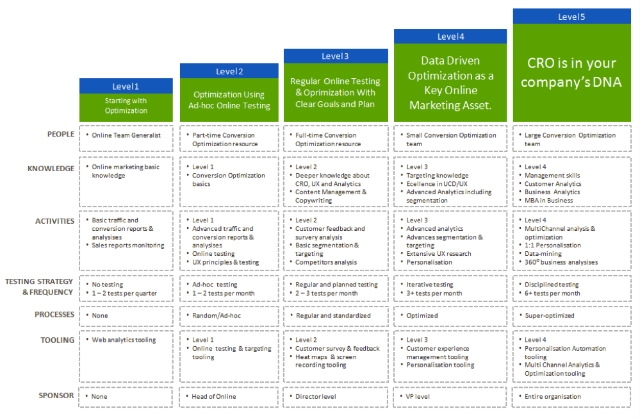Over the years I have seen some companies doing very well in terms of improving conversion and getting solid results from testing activities; but I have also seen many companies struggling to get good results. This disparity led me to think about what are the success factors that will make the difference between those two types of companies. A maturity model of conversion rate optimization came to my mind as a potential way of defining what are the core assets of a successful conversion rate optimization company.
I have been inspired by Stephane Hamel’s Web Analytics Maturity Model. Stephane did a fantastic job transforming a complex Web Analytics discipline into a maturity model which helps companies to understand better the reality of big data and how they can take advantage of it. By using the model any company can identify where it stands, where it wants to be and how to get there.
The same goal drove me to put together a Conversion Rate Optimization Maturity Model. In the last few years I have identified 7 key pillars of conversion rate optimization. I will briefly introduce them in this article and over the course of next few weeks I will focus on each of them in separate articles.

Conversion Rate Optimization Maturity Model – full size
1. People
Both quality and quantity of your team is essential. The 90/10 rule by Avinash Kaushik can be applicable on the conversion optimization area as well. For every $10 spent on tools, you should spend $90 on your staff. Without a good team your fancy and sophisticated tool is useless. The scale usually goes from Online Marketing Generalist to a large Conversion Optimization team including analysts, testing managers, interaction and visual designers, front-end developers etc.
2. Knowledge
Knowledge is aligned with People. In fact, it is part of People, but I wanted to give it more space and describe what knowledge is when it comes to have a conversion optimization mature company/team. It starts with online marketing basics, having an overview of what ecommerce is, how traffic generation works, what web analytics is and how to read reports and take actions. Then you add online testing knowledge, principles of user experience, web analytics knowledge & copywriting skills. It is impossible for a single person to be an expert in all those areas. Therefore at some point a company needs to have a well-acting team.
3. Activities
What do you do on a regular basis to increase your conversion rate? There are various quantitative (purchase funnel analyses, traffic sources overview etc.) and qualitative (usability testing, customer surveys, personas etc.) analyses and activities you can run and which can help you to understand better your customers and how to improve your online business. There are two important factors regarding those activities: quality and frequency. No need to be an expert to understand that the higher quality & frequency the better.
4. Tests Strategy & Frequency
One of the main CRO activities is certainly A/B and Multivariate testing. The testing strategy, quality and frequency of your tests say a lot about your conversion maturity level. Maturity of your testing processes is extremely important: your tests can be executed on a ad-hoc base. Or if you are more mature, you plan and execute in a testing roadmap. Or better, your tests are run in an iterative manner.
5. Processes
The overall CRO processes in your company is another important asset. Do your key departments cooperate smoothly? How about communication and politics within your company? Do you use deliverables like testing roadmaps, testing summaries and learnings overviews? All of these are variables which influence your conversion optimization results significantly.
6. Sponsor
A sponsor is usually a high-ranking employee who has a trust in you and optimization and fights for budget. He supports the conversion optimization efforts and shares the plans and results if you can’t do that yourself. It is an important person particuralrly in corporations where traditional business hiearchy takes place.
7. Tools
And in the end we can’t miss tools. Although the right people are more important than the right tools, you need to have tools in place to be able to conduct your analyses and tests. For every area there are many tools available today. Various web analytics vendors, heatmaps, surveys, feedbacks, targeting and testing tooling. In general the more mature you are the more sophisticated tools you use.
Closing Thoughts
As I mentioned in the beginning later on I will give every pillar a detail focus by describing all levels and key aspects. What it takes to get there, what are the benefits and possible problems.
And now it is your turn. Do you believe a conversion rate optimization maturity model can help your organization to improve your optimizitaon activities and in the end improve the results? Do you agree with the seven pillars I have outlined? How the maturity model should look from your perspective?
Post Scriptum: if you read Dutch, also check out Janco Klijnstra’s Conversion Rate Optimization Maturity Model.








